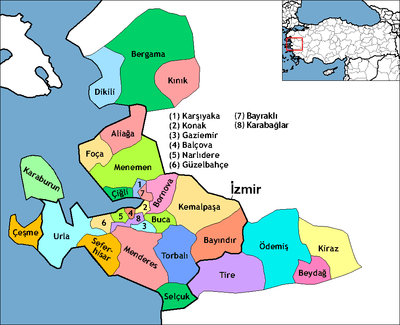Balçova
| Balçova | |
|---|---|
| Town | |
|
Entry gate of the thermal baths associated with Agamemnon in Balçova | |
 Location of Balçova within Turkey. | |
 Balçova Location of Balçova within Turkey. | |
| Coordinates: TR 38°23′08″N 27°03′29″E / 38.38556°N 27.05806°E | |
| Country |
|
| Region | Aegean |
| Province | İzmir |
| Government | |
| • Mayor | Mehmet Ali Çalkaya (CHP) |
| Area[1] | |
| • District | 21.22 km2 (8.19 sq mi) |
| Elevation | 0-432 m (−1,417 ft) |
| Population (2012)[2] | |
| • Urban | 77,843 |
| • District | 77,843 |
| • District density | 3,700/km2 (9,500/sq mi) |
| Time zone | EET (UTC+2) |
| • Summer (DST) | EEST (UTC+3) |
| Postal code | 35x xx |
| Area code(s) | (0090)+ 232 |
| Licence plate | 35 |
| Website | www.balcova.bel.tr |
Balçova (pronounced Balchova), is a district of Izmir Province in Turkey. It is one of the nine districts in the Greater Metropolitan Area of Izmir, the smallest in terms of area. Balçova is a fully urbanized at the rate of 100,0 per cent and the center has no depending townships with own municipalities or villages. Balçova district area follows the southern coastline of the inner Gulf of Izmir, on the road to Çeşme and is at a distance of 8 km (5 mi) to the west from the traditional center of Izmir (Konak), which it borders on the east. Balçova district further neighbors the district area Narlıdere to the south and the west, both of its neighbors being among Izmir's metropolitan districts. Balçova district's overall levels of education are among the highest in Turkey, the literacy rate reaching 98 per cent, while the calculations for average yearly income per inhabitant situate it slightly below the national average, at 4.327 US Dollars, for which its open approach to outside immigration may have played a role. The overall appearance of Balçova leaves the impression of a locality where people are generally educated and who subsist on mid-revenues. The economy is largely based on commerce and tourism, its three shopping malls constituting the backbone for the first range of activities, and its thermal baths for the second. New housing projects putting Balçova's advantageous location to benefit and generally aimed at mid- to higher- income residents started to be built in recent years and as such, Balçova became in recent years one of Izmir's metropolitan districts where the economy grew the fastest. Balçova is home to Izmir University of Economics.
Agamemnon Baths
The baths are well-known since antiquity and the name ancient, and makes reference to a contingent of Greeks under Agamemnon during the Trojan War who were led by an oracle to the warm springs to heal their wounds after a battle. Aelius Aristides had also frequently resorted in the baths and had reported that it was here that Asclepius had first began to prohetise.
A number of sulphurous hot springs rise in and around a small stream, which previously dried up in summer, but which is now kept in service all year round thanks to modern installations centered around a five-star hotel. The waters, of a temperature of to 160 degrees Fahrenheit, are considered good for rheumatism, sciatica, gallstones and eczema. The baths are remain extremely popular both by themselves and by the thermal establishment's having extended its range of activities also in the field of congress and exhibition tourism.[3]
Visitor attractions
Two decommissioned ships of the Turkish Navy, a submarine and a frigate, are the main attractions of the İnciralti Sea Museum.
Resources
- Report: "Balçova, 42 p." Check
|url=value (help) (PDF) (in Turkish). İzmir Chamber of Commerce. 2007. External link in|publisher=(help)
External links
Footnotes
- ↑ "Area of regions (including lakes), km²". Regional Statistics Database. Turkish Statistical Institute. 2002. Retrieved 2013-03-05.
- ↑ "Population of province/district centers and towns/villages by districts - 2012". Address Based Population Registration System (ABPRS) Database. Turkish Statistical Institute. Retrieved 2013-02-27.
- ↑ In his 1966 archaeological guide on Aegean Turkey, George E. Bean, who remains one of the foremost references for the region, notes that, on the signpost for the baths, Agamemnon had become "Ağamemnun" (literally, "the agha is contented" in Turkish), adding, in time, no doubt, he would become "Memnun Ağa". George E. Bean. Aegean Turkey: An archaeological guide ISBN 978-0-510-03200-5, 1967. Ernest Benn, London.
